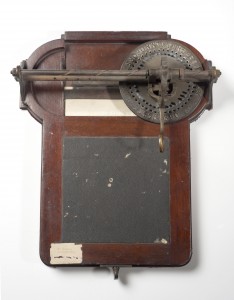Typograph, by W. Hughes, 1850. Wood, brass and paper. Dimensions: 420 x 350 x 120mm
RNIB Collection Accn No: Mus/5
The Typograph, invented by W. Hughes, Director of the Henshaw Institution, Manchester, was one of the most successful early typewriters designed for blind people, winning medals at the Great Exhibition of 1851 and again at the Exhibition of 1862: Pierre Foucault’s writing machine for blind people, the ‘Clavier Imprimeur’ was another notable winner. Hughes’s machine operated by means of a circular index mechanism with lever-operated plungers for each letter, producing both embossed Roman characters as well as visible typescript when carbon paper was used. The Typograph was used in schools for blind people throughout the 1850s. Pupils were often taught different embossed systems for reading and writing.
Object Description:
This machine is made of mahogany wood and brass. It consists of two sections. The first section is a wooden surface, with a clasp in the middle of the bottom edge. The second consists of a wooden tray with rounded edges: a grooved bar runs across the middle of the tray from the widest point of each curved end. On the left hand side, a brass circular index mechanism is positioned, with raised Roman alphabet letters evenly spaced around its outer edge. In the centre of the tray, underneath a wooden shelf feature, a piece of paper is positioned. [end description]
